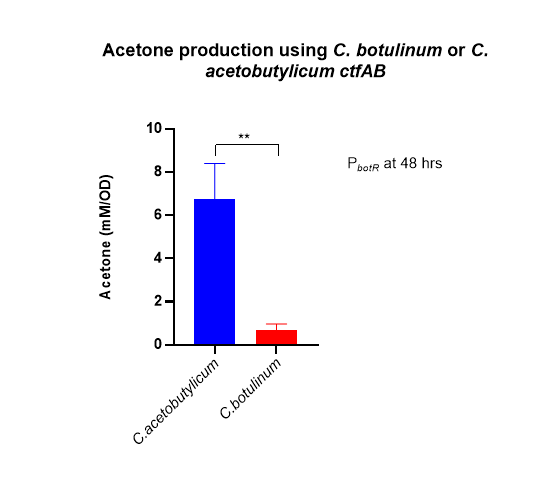Part:BBa_K2992005
ctfB from C. Botulinum
ctfB encodes the B sub-unit of Butyrate-acetoacetate CoA-transferase complex.
Usage and Biology
The CtfAB complex is central to to the production of biotechnologically relevant solvents in C. acetobutylicum such as acetone and butanol. The complex catalyses the conversion of acetoacetyl-CoA to acetoacetate concomitant with the transfer of CoA to acetate and butyrate. the CtfAB complex is a core component of our acetone production pathway to validate the use of volatile reporters to predict botulinum toxin production following food manufacturing processes. We have tested both C. acetobutylicum and C. botulinum-derived ctfAB.
Characterisation
This basic part was used to assemble our acetone producing composite parts and characterised using reporters:BBa_K2992028, BBa_K2992029, BBa_K2992030, BBa_K2992034, BBa_K2992035, BBa_K2992036.
To test our acetone production pathways, we transformed pMTL82151 plasmids encoding our acetone pathways using C. botulinum ctfAB BBa_K2992029 or C. acetobutylicum ctfAB BBa_K2992036, both under the control of PntnH, into our PbotR-botR reporter strain of C. sporogenes.
The data clearly indicates that ctfAB from C. acetobutylicum was much better suited to providing acetone production capacity to our C. sporogenes reporter strains. As a consequence, we selected the acetone production pathway cb_PntnH-5-UTR+RBS-ca_thl-ca_ctfAB-cp_TFdx BBa_K2992036 to assess acetone production in all of our promoter-botR genome integrant strains. The construct was cloned into pMTL82151 and transformed into our various promoter-botR strains and controls.

The data demonstrated appreciable acetone production of >2nM concentration when using either the native PbotR promoter and associated 5’-UTR+RBS or the RBS only construct to permit polar transcription from PpyrKDE. Considerable acetone production (4-6nM) was observed when using the constitutive clostridial promoter Pfdx. Crucially, acetone production was comparably scant when botR was absent from the genome of C. sporogenes and when no promoter was used to drive expression of the acetone production operon. These data provide experimental validation for the production of acetone in C. sporogenes as a model for Botulinum toxin prediction in foodstuffs.
More information can be found on our Results Page.
Sequence and Features
- 10COMPATIBLE WITH RFC[10]
- 12COMPATIBLE WITH RFC[12]
- 21COMPATIBLE WITH RFC[21]
- 23COMPATIBLE WITH RFC[23]
- 25COMPATIBLE WITH RFC[25]
- 1000COMPATIBLE WITH RFC[1000]
References
Vital, M., Howe, A. and Tiedje, J. (2014). Revealing the Bacterial Butyrate Synthesis Pathways by Analyzing (Meta)genomic Data. mBio, 5(2).
| None |

